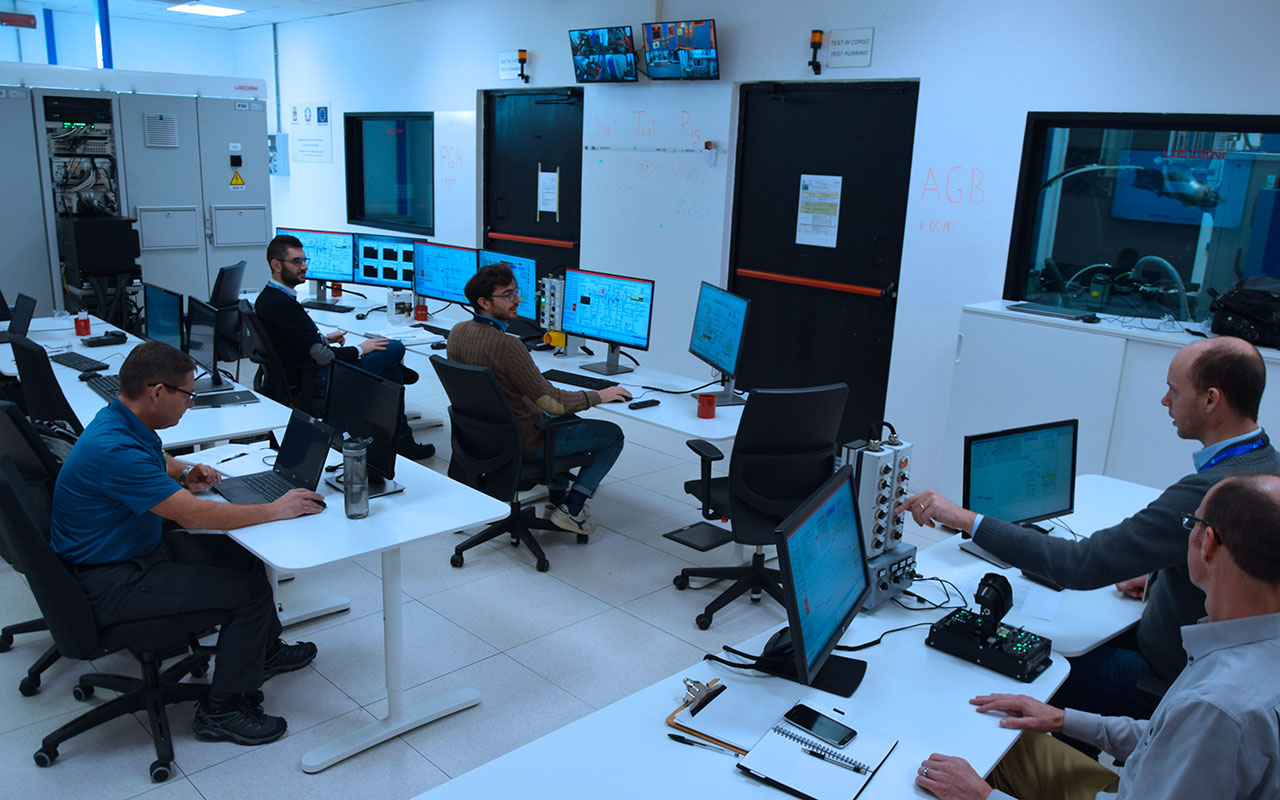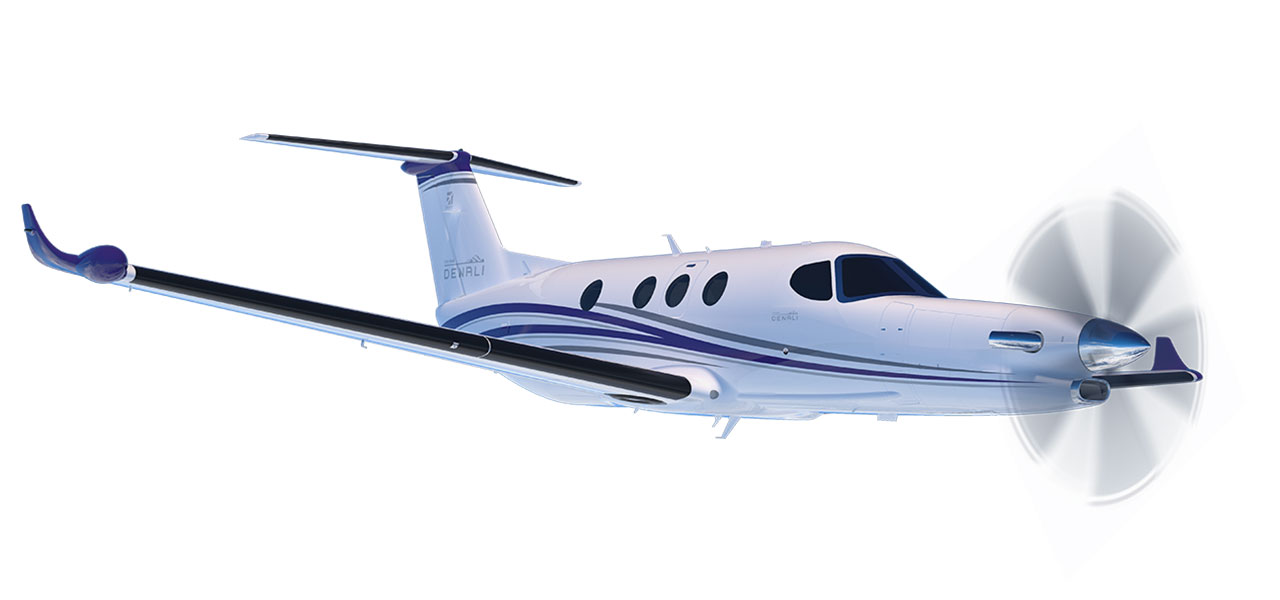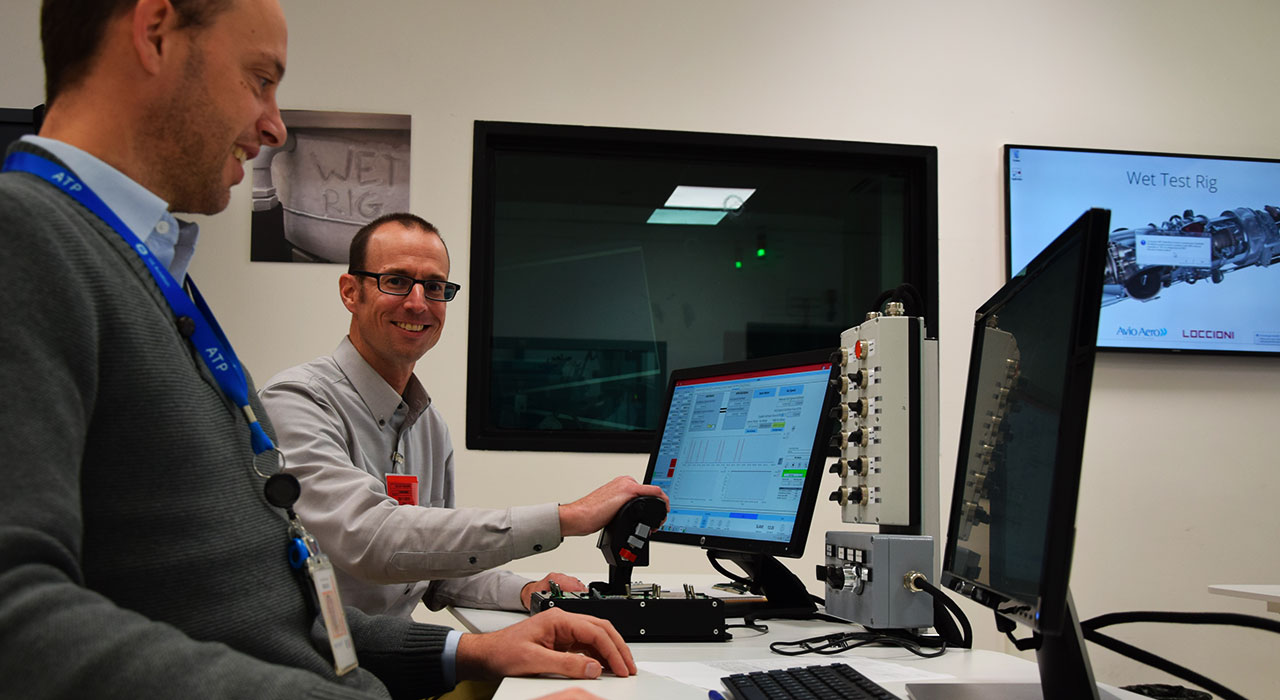Invent
The Propeller Heads
Two engineers, both eager pilots, inside the test facility that allows the most realistic flight simulation for the Catalyst engine, applying real components and weather conditions.
Jan 2019
Two years ago, Simone Castellani, along with Susanna Chakrokh, Cristian Lai and the entire team in the Avio Aero laboratory in Bari, breathed life into the "digital brain" of the Catalyst engine, otherwise known as the FADEC (Full Authority Digital Engine with integrated propeller Control). The turboprop engine which will equip the brand new Cessna Denali from Textron Aviation, has aced its certification tests and is on track to take to the sky in 2019.
We can speak of a phenomenal development stage considering that the engine in question started in 2015 from a blank sheet, enclosing revolutionary innovations (digital controls, but also over 30% of the components printed in 3D) and that, for the first time in the history of GE Aviation, it was designed and built exclusively in Europe: in the industry, the average development for a brand new engine is about 10 years. So Castellani, along with his team and the other Avio Aero teams responsible for designing and manufacturing several engine’s modules, has been quite busy with the FADEC with integrated propeller control.
This "digital brain" is as big as a videogame console that - thanks to the most advanced digital controller, monitoring sensor and smart actuation technologies (which process parameters like altitude, pressure, temperature, turbine and aircraft speed, engine rpm) - allows pilots to use single control lever. Instead of using one lever for engine power and another for propeller control, as has been done on turboprops for the last 30 years, the Catalyst engine’s FADEC “not only brings the common jets power management philosophy to the General Aviation Turboprop world”, but it does it through a Single Lever only. "Above all, it saves the pilot from the burden of continuously adjusting throttle demand and monitoring the various gauges in the cockpit during any taxi or flight phase, optimizing the flight experience and making it much more enjoyable," as Castellani explains.
Therefore, experts and professionals from all over the world visited Avio Aero's Wet Rig in Brindisi: inside this test facility – just next to the Avio Aero plant (where a new additive manufacturing area for 3D printing of GE Catalyst components has just been established) - the engine operations, and specifically the FADEC with integrated propeller control, can be tested together with the actual engine actuation systems (Propeller System, Oil System, Fuel System) both on a functional and a mechanical basis. The Wet Rig even integrates a fully representative propeller test bench where aerodynamic and hydraulic load throughout the entire flight envelope are reproduced.
Brian Cozine is Head of Propeller Design for the Cessna Denali at McCauley (the American company that is exactly the same degree of kinship with Textron Aviation as Avio Aero has with GE Aviation) and, obviously, he visited the Wet Rig as a guest of Simone Castellani. Cozine was intensely interested in one of the two rooms where real components are tested by the electronic simulation of the Catalyst engine: the test room for the power transmission designed and produced in Avio Aero. The one that powers the very solid, and at the same time very light, composite material propellers that McCauley is making for Denali.
"The Wet Rig in Brindisi is a unique testing room, world-wide," Castellani says, standing with Cozine in front of a throttle setup that bears some resemblance to the bridge of the U.S.S. Enterprise in Star Trek. "Here we verify the ability of the FADEC with integrated propeller control to program and manage oil, fuel and air flows, testing the operation of the entire engine system at any real operating speed, as it is electronically simulated in real time. The simulator interacts with the FADEC that monitors and controls the various sensors and actuators, translating electrical inputs into electrical and mechanical outputs which regulate the pitch of the propeller, the flow of fuel and air during each phase of flight or under any weather condition recreated on the test bench.”
Cozine is fascinated by the way this rig in southern Italy can perform such accurate tests, as he similarly experienced how Textron Aviation provides industry robust testing technology: "The simulator at the Wichita headquarters (Kansas, USA, ed.) is called Iron Bird and is dedicated more to flight simulation and engine performance from a digital viewpoint. We recently received a FADEC with integrated propeller control and installed it to verify its integration and operation in the Wichita system.”
McCauley of Textron Aviation is one of the world's largest manufacturers and designers of aeronautical propellers: over 500 models in production, on the most legendary propeller airplanes (Beechcraft, Cessna, Piper, Stoddard Hamilton and many more). "The Denali 5-blade propeller has been designed with composite materials that give it perfect aerodynamics that can be integrated with both the aircraft and the engine to offer excellent performance” continues Cozine.
In his first Italian mission, Cozine focuses his attention on four key elements: speed, thrust, noise and weight. “Textron Aviation and McCauley want to make sure that the Wet Rig provides useful answers in terms of thrust and power expressed in horsepower, or that it confirms the synchrony between the two. And here, for the first time, after three years of intense collaboration with the Avio Aero team for Denali, I got a satisfactory response on the joint operation of the engine and propeller.”
This is also the first time in turboprop history that it has been possible to simulate the human experience of real flight inside a test room, before the real plane (and the whole engine) was tested. "I hope that my team understands the wide range of possibilities offered by the Wet Rig simulation and how much the operating conditions reproduced here are impossible or very expensive to reproduce in the real world” says Cozine.

Answers coming from the Wet Rig tests are fundamental, especially for the engine and the airplane end users to whom Cozine and Castellani dedicate their passionate work. Indeed, beside their common technical-professional mission, both share love for flying: they are pilots. "Even if Brian has been flying for over twenty years and has a lot more experience than I," hastens to say Castellani, who has been attracted to the small airport he grew up near since he was three, so much so that he got his pilot's license as soon as he could.
And any (few) times he can afford to take a break from testing and advancing the program, Castellani can hardly wait to climb into the cockpit: “when you work in aviation, especially in private aviation, and you are close to the product, a license to fly is highly recommended... it gives you a passion for what you do and a real perspective on the product”.
On the other hand, Cozine has always loved constructions, almost becoming a civil engineer: perhaps it was enchanted as a child by the remote-controlled airplanes which dissuaded him from that child’s professional dream. "In high school, a teacher took me on a real flight lesson as a reward: that was probably when I fell in love with planes. I like their structure, so robust yet so light and slender, as well how they are built. Being a pilot and working in the aviation industry allows you to think of higher-level products, in line with what a pilot expects," concludes Cozine.
"I like planes' structure, so robust yet so light and slender. Being a pilot and working in the aviation industry allows you to think of higher-level products, in line with what a pilot expects."
There is only one issue Cozine and Castellani disagree upon: the influence of the engine on the overall performance of the aircraft. For Cozine, it reasonably weighs 50%; but for Castellani, it can easily represent 95%. But these are just opinions.
Cessna Denali images in the page are courtesy of Textron Aviation ©







